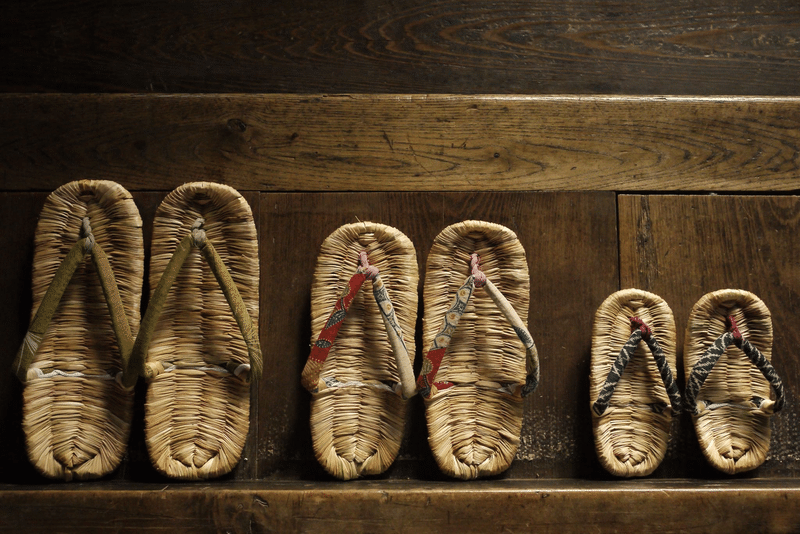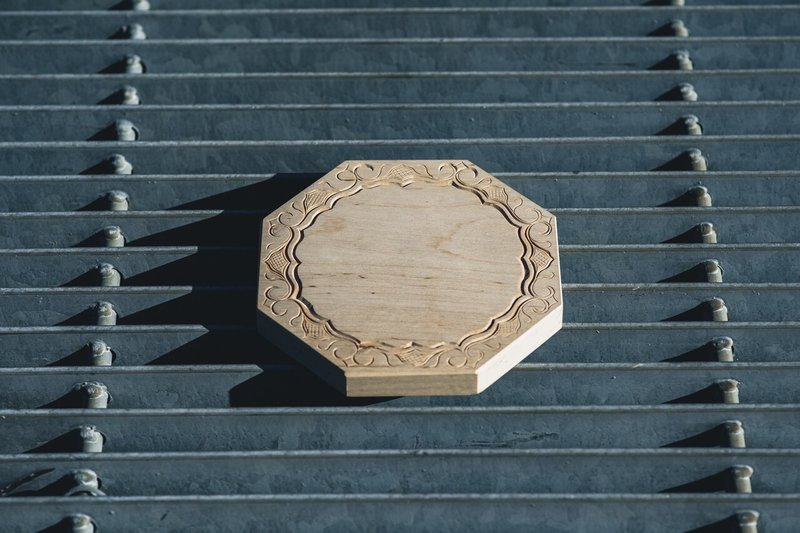
Taking Pains, Making Money and Connecting to the World: A Conversation on Commerce and Environment with Hideharu Taira (woodcarver) and Masanori Naruse (Hijirisha)
A woodcarver who engraves natural materials with patterns cultivated throughout history. A sandal maker who has brought a technique that was in danger of disappearing into the present day. How can we create sustainable environments for making craft? From Kyoto to Hokkaido, from Tokyo to Yamagata, how can we define the sprouts of a new kind of small ‘business’ that emerges from this conversation with two people who are continuing handicraft traditions in new places.
Above: Hideharu Taira (Woodcarver). I liked Hokkaido and made a number of trips there. One year I became intrigued after meeting a woodcarver in the Akanko Ainu Kotan. Later, I moved there to take up a part-time job at a shop in the Ainu Kotan. While I was working there, I met my future wife who was born in the Ainu Kotan and worked in the shop across the street. These days we work together making wooden sculptures and other traditional Ainu crafts.
Below: Masanori Naruse. Born 1980 in Gifu Prefecture, Naruse moved to Yamagata Prefecture in 2009. After studying philosophy at university in Tokyo, he was involved in regional revitalization initiatives as a staffer for the Haguro Tourist Association. In 2013 he struck out on his own and established his business, Hijirisha. He is involved in a number of creative endeavors including holding space for spiritual practice in the Yamabushi mountain ascetic tradition, performance and zine making. He runs a community business based on mountain foods and handicrafts.
Let me start by asking you to introduce yourselves?
Hideharu Taira (T): I work in a shop in Akanko Onsen that sells wood carvings. I am originally from Kyoto but when I was about 22, I started looking for a part-time job and came across an advertisement for a position in a giftshop in Akanko Onsen. The ad said ‘you can also do wood carving which roused my interest and that’s how it all started. I had visited Hokkaido for travel and liked the place. After the job finished, I thought I might go back to Akanko one more time before finding a real job but once I was there it was like I just kept putting off leaving (laughs). And that’s how I came to be carving wood here for 30 years.
Masanori Naruse (N): I make Japanese zōri sandals in Yamagata using a variety of bulrush known locally as ‘oe’. I was born in Gifu Prefecture and studied natural philosophy at a university in Tokyo. After I started working, I was involved in municipal and regional revitalization jobs. At the same time, I started visiting Yamagata about once a month in order to deepen my understanding of the Yamabushi spiritual tradition of the Dewa Sanzan mountain region, which I had first encountered as a student. Then in 2009 I heard about an opening for a permanent position at the Haguro Tourist Association in Haguro and made the move. After working there for 4 years I went my own way but I continue to live in Haguro.
My interest in the Yamabushi culture of the Dewa Sanzan region of Yamgata stems from my thinking about how to live a human life during a time of growing awareness about global warming and nature conservation. Globalization is an enormous current which we can neither reverse nor escape. In the midst of that, I thought that penetrating into the Yamabushi culture might offer new insights.
▲The giftshop where Taira works and his workshop.
Can you tell me about something in your work that makes you feel connected to your region?
T: It means that I use a lot of local materials. I go out to collect the materials by myself so that I don’t need to specially order them in from afar. Usually, I cut green wood in the mountains with the permission of the landlord. The small pieces dry quite quickly and can then be used for carving.
N: When I met a local grandmother who was making bulrush sandals I thought, if this person is unable to keep making these, then this wonderful handicraft and the act of making these sandals would disappear completely from this world. This moved me and I thought about whether there was something I could do. This is a handicraft rooted in the local, but I think its relationship to the wider world in which we live also gives us a lot to think about.

▲Naruse learned how to make these bulrush zōri from Shige Watanabe, who was born in 1922. Thanks to her teaching, he can share them with new people.
What is it that connects handicrafts to the world outside?What is it that connects handicrafts to the world outside?
N: Our consumption and production is connected to the world isn’t it? Some consumer goods are sold for unbelievably low prices. In the background are problems such as low-wage employment and child labor under harsh conditions as well as environmental destruction. At the same time, we have less money and the poverty rate is increasing. If we are experiencing globalization and we cannot avoid it then the issue becomes how do we shift the circumstances. In my case the issue is, for example, how to position my handicrafts. Do I make sandals for everyday use that embody the beauty of function? Or do I add value by increasing the level of craftmanship.
Either way, one has to work out an arrangement that makes it possible to continue making them. I decided to try and create an economic sphere, even a very small one, that would make a fair business viable and enable me to get my sandals to the people who want them. There are certainly people out there who trade in this way and consumers who want it. I am conscious of the fact that it is this kind of people who are supporting me.
T: When you run a giftshop, it is surprising how cheap some of the items available from the wholesalers are. There is a significant difference in price between these items and our own laborious carvings. Furthermore, it is impossible to make the same thing for the same price. While there are people who value handicrafts just as Mr Naruse observed, there are of course some customers who would prefer something cheaper. This makes things difficult.

▲Taira made this cutting board and finished it with vegetable oil so that it can be used for food. This is his first attempt at making a utilitarian object. (Photo: Yuri Manabe)
I am intrigued by how the two of you approach business.
T: I do not receive many direct orders. I mainly make things to sell in the shop. As I said earlier, however you look at it something that takes a lot of time to make is going to be more expensive. But it’s hard to sell expensive pieces so I try and think of pieces that can be made easily and cheaply.
Still, when you compare my level of enthusiasm for carving cheap items that sell well with carving more time-consuming pieces, making cheap things can turn into a bit of an assembly-line. If that is all you do, then your skills atrophy too. That’s why I try and make both cheap things that sell well and more time-consuming expensive items.
N: Many of my orders come via word of mouth. People hear about me at events where I have been invited to contributed or through websites. Other times it is a friend of a friend or an article in a magazine. There are also some trustworthy wholesalers who distribute my sandals to shops in other parts of the country.
In terms of what Mr Taira said, my way of doing things does not allow for mass production so I have no alternative to but to really get across the connection between an item’s price and its value. Behind the price of an item is an ‘environment that enables production, including the natural environment and human relationships. One might even call it culture. It is only because there are people who support my enterprise as a whole by purchasing my sandals, that I can reproduce an ‘environment that enables production’. I think that in business, this is one ideal.
Mr Taira, your current initiative looks like it could lead to something new both in terms of communication and reproducing your environment.
T: This cutting board with an Ainu pattern is totally different from the ornaments I usually make because it can be used, for serving foods like ham and cheese. But if it was just utilitarian, there wouldn’t be much point in my making it, so I am making it a decorative object too. This design uses a kudzu motif that can also serve as a ward against evil.
There was a time when bear carvings sold really well. Now woodcarving is in decline, so I thought this might be an opportunity to bring more customers to Akanko. As someone living in the Ainu Kotan, I thought this was something I could do to disseminate Ainu culture.
N: When I first started Ainu woodcarving I was impressed by the beauty of the patterns. Perhaps its because I am an outsider but I don’t have much sense of their religious significance. But gradually, as I began to carve patterns into my own belongings, I started to understand that idea of protecting something from evil. Precisely because I am an outsider, I want to communicate the value of Ainu culture in my own way.
When I look at Mr Taira’s work, I sense something there that could only be described as ‘the sacred’. It is something exalted beyond the reach of us humans. I can feel it whether it’s in the bear carvings, owls or Ainu designs. It’s like they are conveying something that has no fear of human beings. To put it another way, it’s as if we humans are surrounded by these presences.
There are similarities with Yamabushi understandings too. The Yamabushi believe that there are domains in which human beings cannot just do as they like. Living people are only one part of this world. At a time when we are facing climate change, I think this kind of intuitive understanding is important. And I think that without a doubt, this will lead us to a new craft that is neither souvenir nor artwork. I see this place Akanko Onsen as providing an opening towards such a future for craft.

▲This cutting board, which is both utilitarian and decorative, will allow different kinds of people access in their daily lives to the woodcarving techniques Taira has been developing for 30 years (Photo: Yuri Manabe).
This way of life that depends on commodities made by faceless producers connected on a global scale; how long can it continue? With goods that are produced through handicraft production, we can appreciate that somebody made this object and the feeling they put into it. It definitely seems as if a new economy born out of connection is beginning in Akanko Onsen.
Translation: Alexander Brown
この記事が気に入ったらサポートをしてみませんか?
